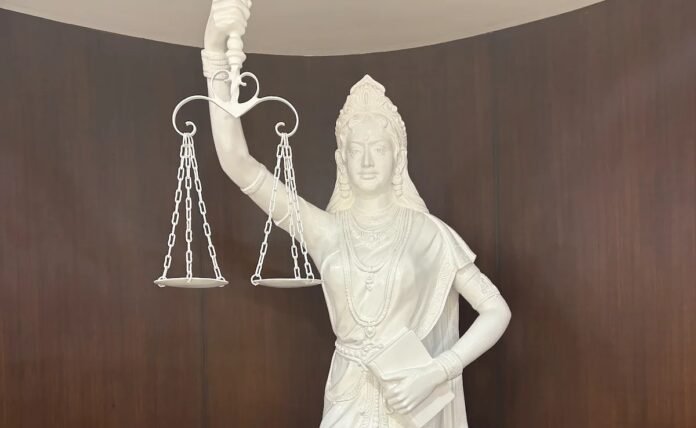In a bold symbolic shift, the Supreme Court of India has unveiled a new statue of Lady Justice, a figure traditionally associated with blindfolded impartiality. This new representation, however, breaks from tradition by having its eyes open and holding the Constitution of India, rather than the customary sword, reflecting a deeper message: the law in India is neither blind nor punitive.
The statue, commissioned at the behest of Chief Justice DY Chandrachud, now stands tall at the judges’ library in the Supreme Court. According to reports, Chief Justice Chandrachud’s vision for the statue was to convey that the Indian justice system, rooted in constitutional principles, is open-eyed and inclusive, ensuring equality for all.
A Departure from Tradition
Historically, Lady Justice has been depicted as a blindfolded woman holding scales in one hand and a sword in the other. The blindfold symbolized impartiality, suggesting that justice should be delivered without regard to social standing, wealth, or power. The scales signified fairness, weighing both sides of a legal argument before reaching a verdict. The sword represented the power and authority of the law, suggesting its ability to punish those who violate it.
However, the new statue challenges this colonial-era imagery by removing the blindfold and replacing the sword with the Indian Constitution. This change reflects the belief that the law should not be blindly applied but should instead be informed by the nuances of each case and grounded in constitutional values.
A New Vision for Justice
The shift in symbolism is a direct reflection of Chief Justice Chandrachud’s philosophy. According to top sources close to the Chief Justice’s office, he believes that the law is not blind and that justice must be administered with eyes open to the realities of society. “The blindfold suggests ignorance or detachment, but law in India is neither detached nor ignorant. Everyone is equal before the law, and justice must be dispensed based on constitutional principles, not through the threat of violence,” a source shared.
The Chief Justice’s decision to replace the sword with the Constitution further emphasizes this point. The sword, traditionally associated with violence and punishment, is not a representation that aligns with the modern judicial process, which is grounded in constitutional law rather than brute force. In this new vision, justice is not about punishment, but about ensuring that legal decisions are in harmony with the democratic values enshrined in the Constitution.
The Scales of Justice Remain
While the statue has undergone significant symbolic changes, one crucial element remains—the scales. The retention of the scales underscores the continued commitment of the judiciary to fairness and balance. It reminds the public that the courts weigh both sides of an argument meticulously before delivering a judgement.
This is essential to the judicial process, where evidence and legal reasoning are carefully considered to ensure that justice is delivered in an impartial and balanced manner.
Moving Beyond the Colonial Legacy
The unveiling of this new statue marks a significant departure from colonial-era symbols of justice. In the past, many aspects of India’s legal and judicial systems were inherited from British rule, including symbols like the blindfolded Lady Justice. However, this new representation signals a conscious move to decolonize the imagery of justice and align it more closely with the values of a modern, democratic India.
This statue stands as a powerful reminder that India’s legal system is rooted in its own Constitution, and that its judiciary is not merely an arbiter of the law but a guardian of constitutional rights and freedoms. It reinforces the idea that justice in India is thoughtful, informed, and deeply connected to the lived experiences of its people.
A Message for the Nation
The new statue of Lady Justice sends a message to the nation that the courts will continue to uphold the rule of law while staying true to the Constitution. It reflects a forward-thinking judiciary that is aware of societal realities and is committed to delivering justice that is both fair and compassionate.
In this new representation, justice is not blind—it sees, it understands, and it serves according to the principles of democracy, equality, and fairness.


